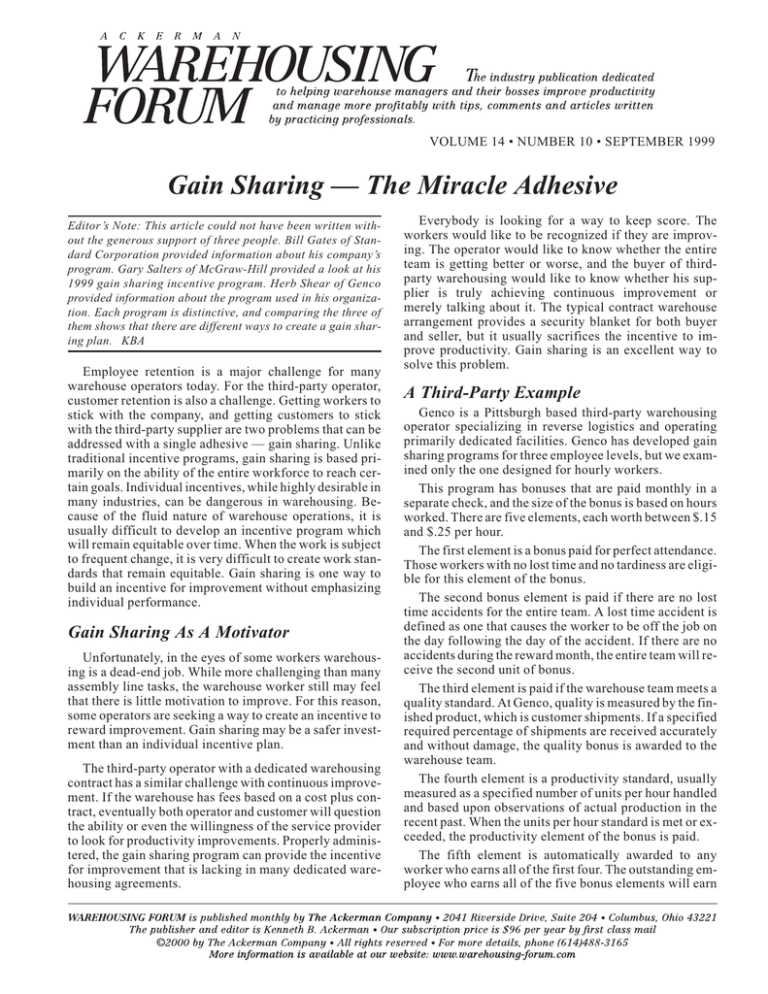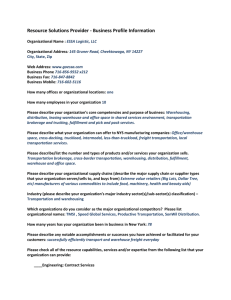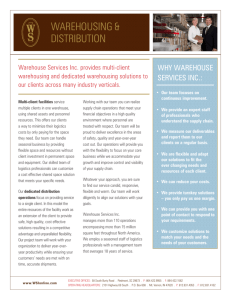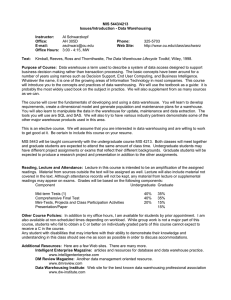Gain Sharing — The Miracle Adhesive
advertisement

VOLUME 14 • NUMBER 10 • SEPTEMBER 1999 Gain Sharing — The Miracle Adhesive Editor’s Note: This article could not have been written without the generous support of three people. Bill Gates of Standard Corporation provided information about his company’s program. Gary Salters of McGraw-Hill provided a look at his 1999 gain sharing incentive program. Herb Shear of Genco provided information about the program used in his organization. Each program is distinctive, and comparing the three of them shows that there are different ways to create a gain sharing plan. KBA Employee retention is a major challenge for many warehouse operators today. For the third-party operator, customer retention is also a challenge. Getting workers to stick with the company, and getting customers to stick with the third-party supplier are two problems that can be addressed with a single adhesive — gain sharing. Unlike traditional incentive programs, gain sharing is based primarily on the ability of the entire workforce to reach certain goals. Individual incentives, while highly desirable in many industries, can be dangerous in warehousing. Because of the fluid nature of warehouse operations, it is usually difficult to develop an incentive program which will remain equitable over time. When the work is subject to frequent change, it is very difficult to create work standards that remain equitable. Gain sharing is one way to build an incentive for improvement without emphasizing individual performance. Gain Sharing As A Motivator Unfortunately, in the eyes of some workers warehousing is a dead-end job. While more challenging than many assembly line tasks, the warehouse worker still may feel that there is little motivation to improve. For this reason, some operators are seeking a way to create an incentive to reward improvement. Gain sharing may be a safer investment than an individual incentive plan. The third-party operator with a dedicated warehousing contract has a similar challenge with continuous improvement. If the warehouse has fees based on a cost plus contract, eventually both operator and customer will question the ability or even the willingness of the service provider to look for productivity improvements. Properly administered, the gain sharing program can provide the incentive for improvement that is lacking in many dedicated warehousing agreements. Everybody is looking for a way to keep score. The workers would like to be recognized if they are improving. The operator would like to know whether the entire team is getting better or worse, and the buyer of thirdparty warehousing would like to know whether his supplier is truly achieving continuous improvement or merely talking about it. The typical contract warehouse arrangement provides a security blanket for both buyer and seller, but it usually sacrifices the incentive to improve productivity. Gain sharing is an excellent way to solve this problem. A Third-Party Example Genco is a Pittsburgh based third-party warehousing operator specializing in reverse logistics and operating primarily dedicated facilities. Genco has developed gain sharing programs for three employee levels, but we examined only the one designed for hourly workers. This program has bonuses that are paid monthly in a separate check, and the size of the bonus is based on hours worked. There are five elements, each worth between $.15 and $.25 per hour. The first element is a bonus paid for perfect attendance. Those workers with no lost time and no tardiness are eligible for this element of the bonus. The second bonus element is paid if there are no lost time accidents for the entire team. A lost time accident is defined as one that causes the worker to be off the job on the day following the day of the accident. If there are no accidents during the reward month, the entire team will receive the second unit of bonus. The third element is paid if the warehouse team meets a quality standard. At Genco, quality is measured by the finished product, which is customer shipments. If a specified required percentage of shipments are received accurately and without damage, the quality bonus is awarded to the warehouse team. The fourth element is a productivity standard, usually measured as a specified number of units per hour handled and based upon observations of actual production in the recent past. When the units per hour standard is met or exceeded, the productivity element of the bonus is paid. The fifth element is automatically awarded to any worker who earns all of the first four. The outstanding employee who earns all of the five bonus elements will earn an extra $.75 to $1.25 per hour (depending on the warehouse location) during the measured month. This program works well because it is easy to understand and because the rewards can be frequently earned rather than being accumulated for a year. A Private Warehouse Example The McGraw-Hill Companies describe their program as the “1999 Gain Sharing Incentive Program.” This program has a number of stated objectives: ■ To measure individual/team performance and to reward employees equitably for their level of productivity in relationship to the total throughput ■ To create an objective way of measuring and evaluating performance ■ To provide consistency and quality in order turnaround and customer service ■ To improve scheduling The standard is based on both attendance and achievement of engineered standards. A worker who meets the attendance requirements receives an incentive pay of $.21 per hour. When performance at 115% of standard is achieved, that worker may earn an additional $.63. However, if the worker can achieve 130%, there is an additional $1.05 of incentive pay. The maximum potential per individual is the total of these three, $1.89 per hour in addition to the base pay. To insure that productivity is not gained at the expense of quality, there are penalty provisions built in for errors in order picking. There is also a formula for providing penalties for cycle count errors and receiving dock errors. For the purposes of administering the plan, there are 65 different productivity tasks and definitions described in the program. A typical warehousing task title is shipping — pallet transport. The standards are set by management, and they are reviewed bi-weekly. Historical data collected in the prior year will be utilized to determine standard for the current year. Each standard is set so the group average equals 110% of the new standard. This means that if the warehouse team has had an average productivity of 110 units per hour, the standard is set at 100 units per hour. Any employee may request a change to the standard, and there is a review committee to handle such questions. The committee consists of representatives from the human resources department, distribution management and warehouse associates on both the first and second shift. Whenever the committee reviews a standard, the results are published and made available to all associates within three days. The senior director of distribution has final approval on any changes that are made to the standards. McGraw-Hill has three centers around the country using the program, and the order profiles are all different so the standards are also different. Gain sharing is alive and well after 12 years because it has been administered as an employee program rather than a management program. Gain Sharing With The Customer The two programs just described are ways of using gain sharing as an incentive for hourly workers. The third example is designed primarily to allow the third-party supplier to share productivity gains with his customer. Standard Corporation is a third-party provider based in Columbia, SC. Many of Standard’s operations are dedicated warehouses, and the gain sharing program is particularly valuable in providing a reward for continuous improvement. Standard’s program is based on a 50-50 division of savings whenever the company is able to achieve results in excess of original projections. In a dedicated warehousing contract, Standard provides a guaranteed level of productivity expressed in units per hour or pounds per hour. Where volume is growing, the operator has more hours to work with and may hire more people. When volume is receeding, the operator must reduce hours worked by cutting the workforce. Assume that the guaranteed productivity level is 150 cases per hour with a throughput of 1,000,000 cases. This means that the operator will expend 6,667 hours to handle the 1,000,000 cases. However, if the operator is able to increase productivity to 200 cases per hour, then the same number of cases will be handled in only 5,000 hours, which is 1,667 hours less than the standard. Assume that the operator bills a variable cost of $20 per hour for labor. This number is multiplied by the 1,667 hours saved to reflect a dollar saving of $33,340. This saving is shared 50-50 between Standard and the customer. Each year, the contract may be renegotiated. In some cases last year’s productivity gain is built into a new productivity level which raises the threshhold. In some cases, savings of up to $1,000,000 have been realized in the early years of a contract as the provider discovered new ways to increase productivity. In other cases, Standard has used a more complex formula. One of these has a cost plus arrangement with specific awards for achieving goals in safety, quality, people turnover, cost, and on-time delivery. When goals are achieved in all five areas, the cost-plus arrangement allows a 20% markup. In the worst case, when none of the goals are achieved, the provider is required to invoice the customer at a money losing 98% of cost. In still another situation, bonuses are based on the ability to beat an established budget. In this situation, the reward for exceeding the budget is a 50-50 split of the dollars saved. Standard also has an incentive program for hourly workers, but this is separated completely from the gain sharing programs just described. The Miracle Adhesive As these three examples have shown, gain sharing means different things to different people. Two of the three examples applied the term to employee incentive programs and a third applied it only to programs to improve customer relationships and encourage continuous improvement. We could describe all three programs as strong adhesives, since they are all designed to either encourage employees to stick with the company or to encourage clients to stick with a service provider. In all cases, either people or companies gain a reward for surpassing certain goals. All of the programs seem to express a belief in the philosophy of kaizen, which is the Japanese term for continuous improvement. Is Warehouse Work A “Dead End” Job? At a seminar, we were dismayed to find a participant who lamented the lack of prestige associated with working in a warehouse. He went so far as to describe this task as a dead end job. I thought this opinion was absolutely off base and not just because I’ve made a living in warehousing for decades. We did not debate with the respondent, but here are the points that we would make to dispute that view. First, there are few blue collar professions where promotion to supervision and sometimes even to senior management is as prevalent as the job of warehousing. A significant percentage of today’s warehouse supervisors began their career as hourly workers. Nobody could call this kind of mobility a dead end job. Second, unlike production work, warehousing involves a wide variety of tasks and a changing environment. Especially in third-party work, the acquisition of every new customer includes a challenge to learn a new job. However even a private warehouse has substantial change as new products are introduced and old ones are phased out. Finally, warehousing involves substantial responsibilities. Warehouse workers are handling products that belong to others, and those “others” rely on each warehouse person to handle them safely and carefully. In most ware- Spotlight On Warehouse Safety It is not easy to find anyone who is opposed to safety, but there is a chronic neglect of safety issues in all kinds of businesses. Unfortunately, the record in warehousing is worse than average. Some efforts are being made. The International Warehouse Logistics Association (IWLA) has developed a 225-page safety manual (847-292-1891). The guide is divided into five categories: ■ Management policy ■ General rules ■ Accident investigation and self-inspection ■ Enforcement ■ Training Government Institute of Rockville, Maryland has published a book by George Swartz, Director of Safety for Midas International. The title is “Forklift Safety: A Prac- house operations, the final inspector is the customer who receives the product shipped from the warehouse. Therefore warehouse workers must be responsible and careful. If they are sloppy in their work, the customer suffers and management pays. Unquestionably, there are those in management who don’t appreciate the complexity of warehousing work. Those of us closer to it need to help develop greater management understanding as well as pride in performance. v v v v v v v v v The Warehouse Industry In A Free-Fall Economy A conversation with an American investment banker who has just migrated from Moscow described how a severe economic crash affected third-party warehousing. Our informant was a shareholder in a third-party logistics organization based in Moscow. It is hard for anyone to imagine the meltdown which took place in Russia in August of 1998. The reaction of many multi-national companies was to stop all inbound movements of product to Russia, to write off the inventory which existed at that time, and then to liquidate that inventory by any possible means, including barter. For the third-party warehouse operator, this meant that revenue virtually died overnight. With no inbound, the cash flow stopped. In some cases, invoices for past services were difficult or impossible to collect. Landlords still tried to collect rent, but revenue to the warehouse had been cut off. In a TV interview, an American academic who is a Russian expert described the August 1998 crash in Russia as something far worse than anything that happened in the great depression of 1929-39. For those who did not see it first hand, it is difficult to imagine. tical Guide To Preventing Powered Industrial Truck Incidents And Injuries” (800-621-0144). The payoff for improved safety is the modification (or mod) rate which is used by Worker’s Compensation insurance carriers. It is derived by dividing the number of incident free hours by the number of employees. A low mod rate is used as a bargaining chip to negotiate lower insurance rates. v v v v v v v v v Tracking Highway Trailers It is hard to believe that anybody could lose anything as big as a trailer, but apparently it happens. When truckers are forced to search for a missing trailer, logistics productivity suffers. Schneider National, Inc., one of the nation’s largest trucking companies, is installing tracking devices in 40,000 freight trailers so it can pinpoint their whereabouts by satellite. The system will not only help find trailers which are misplaced, but it solves two other problems: finding stolen trailers, and identifying those customers who hold trailers for an unreasonable length of time. High Returns Operations & Fulfillment, March/April 1999, pg. 64. This is a report on a panel discussion concerning strategies to keep seasonal workers coming back. The panelists were four representatives of large catalog companies. Several strategies were mentioned. In a tight labor market, schools are seen as a prime source of labor. Recruitment includes high schoolers as well as college students, work shifts of only two or three days per week, and weekend-only shifts. One company brings in high school teachers to help them learn the kinds of skills the company is looking for. Another company is trying to develop a partnership with a local firm that has opposite seasons to allow workers to move from one company to the other and develop year-round employment. Employee referrals are a popular strategy. In one firm that hired 900 people last year, over 500 came from referrals. A referral bonus was paid if the referred employee finished the season. Scheduling is also a repeated priority. One company asks the employees what they would like in scheduling practices. They also use a swing rotation, three days on and two days off. Attendance is rewarded with a bonus. At one company, if you work 100% of the scheduled hours during a two week period, there is a bonus of $2 per hour. v v v v v v v v v Picking Up Pick Rates By Art Avery, Operations & Fulfillment, January/February 1999, pg. 29. This article provides a useful primer on the use of bar codes to implement order picking. Written for catalog warehouses, the article gets back to basics on the advantages of using bar coding in the order pick area. The author claims that picking productivity rates jump as much as 50% after implementation of a bar code program. Most picking errors occur when the picker selects products from the wrong slot, and this can be prevented by affixing bar coded labels to each carton, item and slot. The article provides a sample warehouse layout which shows where bar coding is used and how many checking and picking personnel are eliminated by its use. Another chart shows labor hours extended per day, before and after bar coding is implemented. A model bar code is provided which shows the information that should be included in any coding system. The author warns against the “garbage in—garbage out” problem, pointing out that the bar coding program will not work if an operation is fundamentally flawed. He claims that the cost of equipment to implement a bar coding program should have a payback of six months or less. Firing Up the Front Line By John R. Katzenbach and Jason A. Santamaria, Harvard Business Review, May/June 1999, pg. 107. The challenge of motivating hourly workers is the subject of this unusual article. The authors describe organizations that have done this well, including the U.S. Marine Corps, Toyota, and Tupperware. They point out five methods of creating “emotional energy” among front line workers: P The mission, values and pride path P The process and metrics path P The entrepreneurial spirit path P The individual achievement path P The reward and celebration path While warehousing is not mentioned, many of the ideas in this article are worth careful study by those who are looking for better ways to motivate warehouse workers. v v v v v v v v v Getting Floored By Colleen Gourley, Warehousing Management, January/February 1999, p.43. This article provides a good review of options in finishing of concrete warehouse floors. Surprisingly, the article ignores the most important principle of warehouse floors, and that is the fact that the concrete can never be any stronger than the earth beneath it. The author neglects the importance of properly preparing the soil before the concrete is poured. However, the article does describe three options for concrete. They are a plain concrete floor, one which is treated with a hardener, and one which is sealed with epoxy, urethane, or liquid silicate sealers. The importance of controlled joints and crack repair is explained in detail. The author interviewed vendors of concrete treatment compounds and sealers, and the article describes the features of several of these products. v v v v v v v v v Building bridges between WMS & ERP By Christopher Trunk, Material Handling Engineering, February 1999, pg. SCF7. One of the fastest growing developments in corporatewide software is a system called enterprise resource planning, popularly known as ERP. Many major companies are spending millions to convert old systems to the ERP format. As this article points out, they frequently end up with a warehouse management system that does not fit the new system. The article is based on interviews with a variety of software system vendors. It includes some useful definitions of ERP and other terms used in the process. Other than suggesting that there are ways to build the bridge, the article does not provide any practical solutions to the problem.





